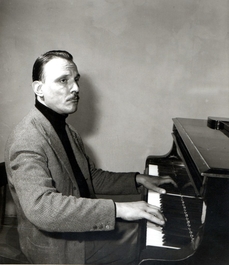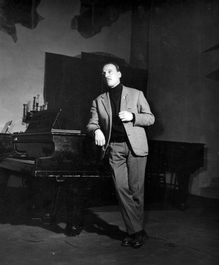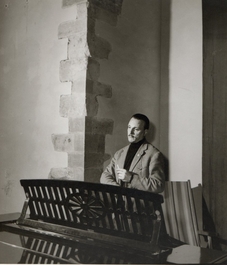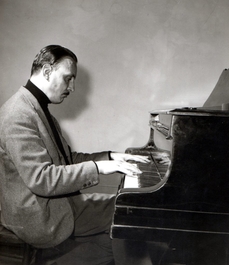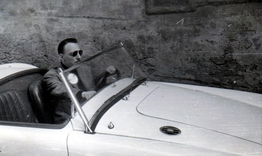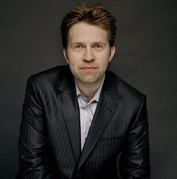Arturo Benedetti Michelangeli
Informazioni
Few pianists have provoked greater awe and controversy than Arturo Benedetti Michelangeli: awe through his crystalline perfection, controversy through interpretations that ranged from the chilly to the sublime. At his greatest the results were unforgettable and, in common with one or two artists in each generation, he could eclipse even his most illustrious colleagues. All who heard him were left with indelible memories of this ‘difficult’ and autocratic arch-perfectionist of the keyboard.
Born in Brescia in 1920, Michelangeli had an exclusively Italian training and at the age of 18 he won seventh prize in the 1938 Queen Elizabeth Competition in Brussels (first and second places were taken by Emil Gilels and Moura Lympany respectively). A year later he eclipsed this modest success when he was the decisive victor in the Geneva International Piano Competition. The jury included Alfred Cortot, who exclaimed, "A new Liszt is born!" A musical genius with an ear for quality, Cortot knew a great pianist when he heard one, and it is interesting that he appreciated so fully an artist whose immaculate brilliance was the antithesis of his own dazzling but erratic pianism.
A man wrapped in an almost mystic aura, Michelangeli enjoyed teaching and later attracted carefully selected students to his annual masterclasses. Descriptions of these vary. Did he teach Martha Argerich silently and from a great distance, as he claimed? And what of the luckless Australian pupil who arrived with one lovingly prepared Beethoven sonata only to be told that he must play another? Frantic, all-night preparation for his lesson the following morning led only to further frustration: the maestro, it seems, had already left Italy for another country. Such anecdotes are complemented by no less intriguing claims that Michelangeli was a virtuoso driver of Ferraris, a fully qualified pilot and, last but not least, a doctor of medicine. Of a naturally reclusive and melancholy disposition, Michelangeli kept his admirers very much at arm’s length, and they consequently spun their own skein of legends around their prized enigma, a pianist once described as being ‘without portfolio’. More serious estimates of his teaching found him a stickler for accuracy, for the sacredness of the score and for a capacity to listen to, rather than merely to hear, one’s own playing. In this respect he resembled Rachmaninov and also Horszowski, who sagely remarked that "becoming a better musician is learning to read a score better". Lessons with Michelangeli could last ten minutes or four hours according to the mood of the moment, and the search for the perfect and apposite sonority could be arduous and intense.
For Maurizio Pollini, who studied with Michelangeli shortly after his own triumph in the 1961 Chopin International Competition in Warsaw, his teacher represented "the absolute peak of piano playing" and never more so than in Ravel’s Gaspard de la nuit. For others he could produce infinite gradations of colour and touch, and draw on mesmeric powers of concentration, qualities that reached their apogee in 1957 when he made his incomparable EMI recordings of Rachmaninov’s Fourth and Ravel’s G major Concertos, performances that excelled even his own Olympian standards.
One could never describe Michelangeli as "sedate and sedative" (Charles Rosen on too many contemporary pianists). Listening again to this keyboard immortal, one can only marvel at qualities that are, indeed, transcendental.
Born in Brescia in 1920, Michelangeli had an exclusively Italian training and at the age of 18 he won seventh prize in the 1938 Queen Elizabeth Competition in Brussels (first and second places were taken by Emil Gilels and Moura Lympany respectively). A year later he eclipsed this modest success when he was the decisive victor in the Geneva International Piano Competition. The jury included Alfred Cortot, who exclaimed, "A new Liszt is born!" A musical genius with an ear for quality, Cortot knew a great pianist when he heard one, and it is interesting that he appreciated so fully an artist whose immaculate brilliance was the antithesis of his own dazzling but erratic pianism.
A man wrapped in an almost mystic aura, Michelangeli enjoyed teaching and later attracted carefully selected students to his annual masterclasses. Descriptions of these vary. Did he teach Martha Argerich silently and from a great distance, as he claimed? And what of the luckless Australian pupil who arrived with one lovingly prepared Beethoven sonata only to be told that he must play another? Frantic, all-night preparation for his lesson the following morning led only to further frustration: the maestro, it seems, had already left Italy for another country. Such anecdotes are complemented by no less intriguing claims that Michelangeli was a virtuoso driver of Ferraris, a fully qualified pilot and, last but not least, a doctor of medicine. Of a naturally reclusive and melancholy disposition, Michelangeli kept his admirers very much at arm’s length, and they consequently spun their own skein of legends around their prized enigma, a pianist once described as being ‘without portfolio’. More serious estimates of his teaching found him a stickler for accuracy, for the sacredness of the score and for a capacity to listen to, rather than merely to hear, one’s own playing. In this respect he resembled Rachmaninov and also Horszowski, who sagely remarked that "becoming a better musician is learning to read a score better". Lessons with Michelangeli could last ten minutes or four hours according to the mood of the moment, and the search for the perfect and apposite sonority could be arduous and intense.
For Maurizio Pollini, who studied with Michelangeli shortly after his own triumph in the 1961 Chopin International Competition in Warsaw, his teacher represented "the absolute peak of piano playing" and never more so than in Ravel’s Gaspard de la nuit. For others he could produce infinite gradations of colour and touch, and draw on mesmeric powers of concentration, qualities that reached their apogee in 1957 when he made his incomparable EMI recordings of Rachmaninov’s Fourth and Ravel’s G major Concertos, performances that excelled even his own Olympian standards.
One could never describe Michelangeli as "sedate and sedative" (Charles Rosen on too many contemporary pianists). Listening again to this keyboard immortal, one can only marvel at qualities that are, indeed, transcendental.
Would you prefer to visit our website in English?



